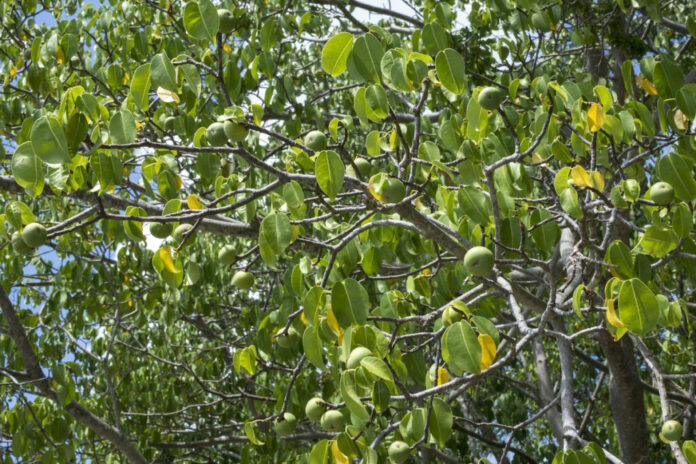On sandy coastal shores, evergreen branching trees grow, their shapes molded by coastal winds into the most whimsical forms. These are the Manchineel trees from the Euphorbiaceae family. The glossy leaves with yellow veins attract the gaze of passersby, prompting them to admire the perfection of these giants, reaching up to 15 meters in height.
Here and there, ripe greenish-yellow fruits peek out, emitting a sweetish aroma. They closely resemble apples, thus instilling trust. Almost unconsciously, one’s hand reaches out to pluck or pick one of them, to satisfy hunger or thirst. But under no circumstances should this be done! For a reason, the Spanish call this plant “arbol de la muerte” – the “tree of death.” All its parts, from root to dense crown, contain toxins dangerous to the human body.
What makes the most poisonous tree in the world dangerous
Simply seeking shelter under the Manchineel tree from the rain can result in severe chemical burns. The toxic compound phorbol, found in the thick white sap, dissolves rapidly in water. If a drop of water first comes into contact with the tree and then with the skin, a blister remains. English naturalist E. Darwin made a note in one of his works: “…the dew which falls from it is so poisonous, as to blister the skin; hence the Spaniards who sleep under it are often destroyed by its branches.”
The branches of the “tree of death” are also unsuitable for evening gatherings around the campfire. Smoke from the wood causes migraines, swelling of mucous membranes, and eye inflammations, and in the worst cases, complete blindness.
The indigenous people used the sap of the Manchineel tree as poison for their arrows. Even enemies who received minor wounds would die in agony, as the milky white sap of the Euphorbiaceae tree entered their bloodstream and gradually corroded their bodies from the inside.
Near growing Manchineel trees, warning signs are usually placed to alert tourists to the danger. Or they are surrounded by red ribbons to protect them from the poisonous plant. Unfortunately, precautions do not always work. There are always those who prefer not to notice the signals. Or they wander so far that there are no signs there at all.
The forbidden fruit of the Manchineel
The greatest danger comes from the fruits. They are very juicy and sweet. In the first few minutes of chewing, a person experiences gastronomic pleasure. But after a few moments, the situation changes drastically: the throat begins to burn, it contracts in spasms. There is a burning sensation in the stomach, followed by vomiting, severe diarrhea, leading to complete dehydration. If only a small bite of the “tree of death” fruit was taken, there is a chance of survival. But if eaten whole – then it’s all over.
In 1999, it happened to radiologist Nicola Strickland. The girl was fascinated by shell hunting and stumbled upon strange apples fallen from a tree onto the sand. She was tempted and took a bite. The subsequent eight hours of suffering she considers the worst she has ever experienced. Since Nicola consumed only a tiny amount, she managed to survive. Later, Mrs. Strickland published an article about this case in the “British Medical Journal.”
Attempt to destroy the Manchineel
In 1733 on the island of Puerto Rico, there was an attempt to destroy all the deadly trees. However, it did not end well. Primarily for the workers involved in uprooting them. The poisonous sap sprayed in all directions from the blows of the axe, causing them injuries, burns, and pain. The wounds they received festered for a long time and did not heal. Then, in order to coagulate the sap, they started burning the bark of the Manchineel. This did not alleviate their plight much – inhaling the toxic smoke sharply worsened their health.
All trees are important
Moreover, the mass destruction of these green giants can lead to natural disasters. It turns out that trees are very important in the ecosystem since their dense crowns act as a natural shield against the wind and protect the coastline from erosion. They provide a habitat for some species of lizards and insects, which the Manchineel does not harm at all.
The wood of the “tree of death” is highly valued by carpenters. They have learned to minimize the risk of poisoning and harvest the valuable wood by evaporating the poisonous juices. The Manchineel has a very beautiful dark texture, so it is predominantly used for making elite furniture. After going through all stages of processing, the wood ceases to be toxic and can be safely used in everyday life.
Manchineels thrive in humid environments. They grow in the Bahamas, along the coasts of Central and North America, in the Caribbean Sea basin, and other tropical regions. Due to its outstanding toxicity, the tree from the Euphorbiaceae family made it into the Guinness Book of World Records and is considered the most dangerous plant on the planet. Fatal cases associated with “death trees” still occur to this day.
